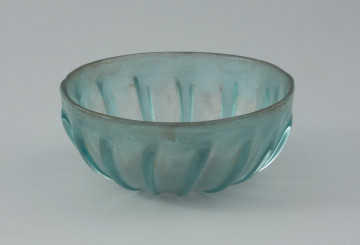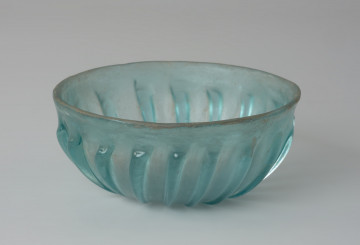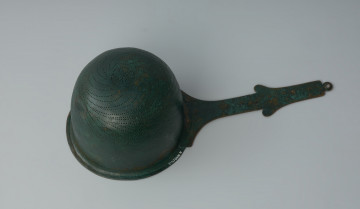
Roman teapot with ribs
National Museum in Szczecin
Part of the collection: Antiquity
Situla is the Latin name for a bronze bucket. The presented specimen represents an early variety of these vessels from the 1st half of the 1st century, with characteristic handle attachments in the form of stylized dolphins. The situla from the Roman Empire was most probably made in one of the workshops in Capua, an important metallurgical centre of that period. Similar vessels were also produced in Romanized Gaul. This particular situla was one of the furnishings of a cremation grave discovered in the Barnisław cemetery before 1828. The situla with attachments belongs to the earliest series of bronze vessels that reached northern Europe from the south. In Western Pomerania, as well as in the rest of northern European Barbaricum, this type of vessel came via the Marcomanni state, founded by Marobod in the Bohemian Basin at the beginning of the 1st century. For this reason, the oldest phase of the influx of Roman imports into the lands of Poland is referred to as the “Bohemian wave”. The Marcomanni state, constantly threatened by Roman attacks, guaranteed its peace from the north, among other things, through the gifts offered to the representatives of the elite tribal communities that were forming at that time. These were mainly bronze and glass vessels, less frequently clothing ornaments such as fibulae and belt buckles. Roman imports are known mainly from the rich graves of the tribal aristocracy.
Bartłomiej Rogalski
Author / creator
Dimensions
cały obiekt: height: 21 cm
Object type
furnishings and equipment; container; vessel (container); situlae
Technique
casting; forging
Material
bronze
Creation / finding place
Owner
Muzeum Narodowe w Szczecinie
Identification number
Location / status

National Museum in Szczecin

National Museum in Szczecin

National Museum in Szczecin
DISCOVER this TOPIC
National Museum in Szczecin
DISCOVER this PATH
Educational path